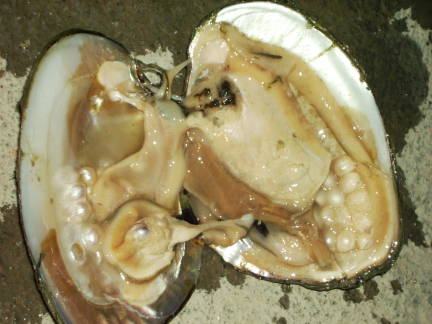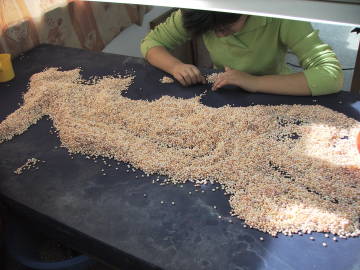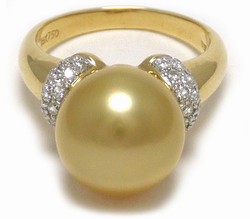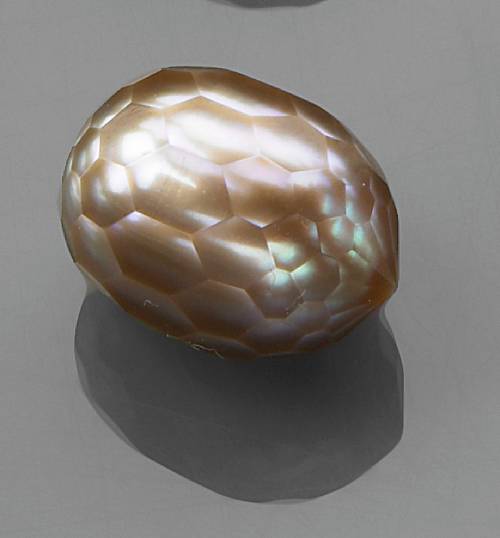 |
| Image via Akoya Pearl |
 |
| Image via Shreve, Crump, & Low Look how beautifully the pearls in this brooch are graduated. |
 |
| Image via Bijouterie Sudha |
Can you just imagine the first guy to crack open a mollusk and find a pearl? I'm sure he was mystified as well as enchanted. I've always felt a bit of an attachment to pearls. As a kid, we used to pry open freshwater mussels out of Sam Rayburn Reservoir in East Texas looking for pearls. Mostly what we found were tiny, flat lumps on the side of the shell but every once in a while, just often enough to maintain the hunt, we would find a nice pearl. By nice I mean a free-floating whopper of 2-3mm. But it was my first exposure to pearls as well as to the truly unexpected odd-ball beauty that God hides in the world for us.
 |
| Image via eHow |
So here you've got this funky, dirty river mussel with a great name like the Texas pimpleback or the fatmucket that you slugged out of the muck and after you've chopped and pried at it for awhile the hinge snaps and the mussel creaks open to reveal.... grossness. So you slide your finger in under the mantel and after a second or two you feel it.
 |
| Image via TN History for Kids |
Oh look- a pearl!
Pearls are the only birthstone that do not need to be cut, faceted, or polished. Pearls are also the only birthstone formed as a result of biological activity of a living organism, the mollusk. Mollusks are a huge phylum of invertebrate animals, of which there are about 85,000 named species. It is the largest marine phylum, making up about 23% of named marine organisms but there are freshwater and terrestrial species as well. Oysters and mussels are the mollusk friends who give us pearls.
 |
| Image via Kevin Main Jewelry |
Now, you don't find a pearl resting luxuriously on a clean bed of satin sheets, awaiting your ring setting. It's much more... slimy.
 |
| Image via Kari Pearls (freshwater pearls) |
So let's begin. An oyster is a living organism.
 |
| Image via Pearl Magpie I love this picture. |
Like all living things, oysters can get irritated. Maybe it's a tiny parasite, a bit of food, or a grain of sand which the oyster cannot eject that gets the pearl ball rolling but something gets inside the oyster (or mussel) and starts to annoy and chafe at all those lovely soft internal organs. Like the tiniest of pebbles in your shoe, the irritant, well, irritates so in response the oyster secretes a substance called nacre, the oyster's saliva. Nacre is composed of calcium carbonate and something called conchiolin, which acts to hold the calcium carbonate together. Nacre is continuously deposited along the inside of the shell as a defense mechanism as well as for structural integrity. On the inner side of the shell, nacre is called Mother of Pearl. In a ball around a nasty irritating bit it is called a pearl.
 |
| Image via Physics.Wisc.edu |
Nacre is continuously laid down in thin layers around the pearl or over the shell and is surprisingly light as well as very strong.
 |
| Image via Berkeley Lab |
Scientists have been working to understand and recreate this strength and structure for such uses as artificial bones, dental implants, airplane manufacturing, and computer components. How cool is that?
Natural pearls are formed all on their own, with no help from anyone and are increasingly rare, found in about 1 in every 10,000 mollusks. They are an accident of nature and form over many years. An oyster pearl may contain only 1 or 2 natural pearls. Used as long as 4,000 years ago, the use of natural pearls in jewelry has been mostly supplanted by cultured pearls since the beginning of the 1900's and the market for natural pearls was virtually dead in the water by the mid-1950's. Interest in natural pearls is making a come back, however. In 2007, a double strand necklace of 68 perfect natural pearls, show to the left, known as the ‘Baroda Pearls’ was auctioned at Christie’s Auction House for $7 million.
Cultured pearls, on the other hand, are formed after human intervention. A tiny bead or a bit of tissue nucleus is inserted into the pearl oyster, for saltwater pearls, or into mussels for freshwater pearls. Cultured pearls are fully pearls, not fake pearls. The difference between natural and cultured pearls can be seen only by x-ray in order to get a look at the center, but other than that they are as much a pearl as natural pearls.
 |
| Photomicrographic image of a pearl via Molecular Expressions I want a print of this for my wall. |
Cultured saltwater pearls come primarily from the akoya oyster pearl and are farmed extensively in Japan and China. The techniques for growing round, rather than flat or misshapen cultured pearls, were developed by Kokichi Mikimoto, the son a Japanese noodle-maker. Today, Mikimoto pearls are highly sought after and are considered to be among the best cultured pearls.
| Circa 1950's vintage Mikimoto pearl earrings. Image via Antique Jewelry Mall. |
Cultured freshwater pearls come out of mussels as opposed to pearl oysters. There may be as many as 50 pearls in one mussel. While they can be farmed in any body of fresh water, a large percentage of freshwater pearl farms are located in the Yangtze River delta of China. Freshwater pearls are known for their wide variety of colors and shapes and are generally more affordable than saltwater pearls. However, the rounder they become the more their value increases. Japan and the United States are significant producers of freshwater pearls but once again, it is China that leads the way. Pearls farmed on Lake Biwa in Japan were of such nice quality that for a period of time all freshwater pearls were called Biwa pearls. However, pollution in the lake began to seriously damage pearl production by the 1970'S. Chinese freshwater pearls, however, began a dramatic climb in quality in the 1980's after a rough start. Remember the "rice krispie" pearls in the 70's? OK, well, some of us do.
 |
| Image via Sudlow Jewelry on Etsy |
South Sea and Tahitian pearls are the fourth type of pearl used in jewelry. South Sea pearls are cultivated in Australia and parts of Indonesia and while these pearls may be up to 20mm in size, they are hard to cultivate. Tahitian pearls come to us from the French Polynesian Islands and can be black, grey, or green-black, bronze-black, even a pinkish variety. Round Tahitian pearls, because they are so difficult to produce, can command very high prices.
 |
| Image via Sunday Observer |
To be honest, there are so many variations of pearls I'm sort of at a loss as to how to present them here. And we still haven't gotten to the history and mystery of pearls. Let's take a quick look at the shapes.
 |
| Image via Gold and Pearl |
 |
| Image via Espy Jewelry |
Blister pearls form when the pearl remains attached to the inside of the shell. These pearls are often left with the shell and fashioned into some very striking pieces.
 |
| Image via Chicago Silver |
They can also be cut away from the shell and set as a half pearl. Blister pearls are sometimes called Mabe pearls but true Mabe pearls are grown in, of all things, Mabe oysters and have a particularly beautiful luster.
 |
| Image via Creeping Vine Designs |
OK- so let's talk about luster. Luster is the bling of a pearl. It's what makes a pearl mysterious. This is oyster saliva, after all. For simplicity (and much more clarity than I could bring to the discussion), I'll quote from the Pearl Magpie:
Lustre is the best expression of a pearl's beauty. It is the quality of the light reflections from the pearl's surface and depends upon the thickness of the translucent layers of nacre. The iridescence that genuine pearls display is caused by the overlapping of successive layers of nacre, these layers break up light falling on to the surface producing that special effect of a deep glow, or rainbow effect on a mirror-like surface finish Thick nacre results in high lustre pearls with sharp and intense light reflection quality and a metal-like steely look (compared to milky, dull and flat looking surfaces), the higher the lustre the higher the value. (quote source)
 |
| Image via Cerise & Co. |
Very briefly, shamefully brief because it's so interesting, pearls are graded by luster, size, shape, color, and surface (degree of imperfections in the nacre surface). We'll touch on this again in a minute.
 |
| Image via Wikimeida Commons |
The largest pearl known pearl in the world a a non-gem quality pearl from the Philippines known as the Pearl of Allah or the Lao Tzu. It is a "clam pearl" from the giant clam, and gemologists refer to it as a non-nacreous pearl since it does not have the luster of pearls from oysters or mussels. It has been valued from $42 million to $93 million. It weighs just over 14 pounds and has been called the ugliest pearl in the world.
 |
| Sorting Pearls. Image via Kari Pearls |
The Latin world for pearl means "unique" as no two pearls are alike. Pearls are among the oldest gems and were long considered to be the most valuable. A fragment of the oldest known pearl jewelry, found in the sarcophagus of a Persian princess who died in 520 BC, is displayed in the Louvre in Paris. Religious and mythological references to pearls have been found in ancient cultures all over the world: India, Persia, North America, Asia, Ceylon (Sri Lanka), and Greece. Pearls have been associated with love, purity, happiness, wealth, power, virtue, and modesty. During the Dark Ages, knights wore pearls into battle under the belief that its luster would give protection and could heal from poisoning.
 |
| Ancient Roman earring, second to fourth century AD Image via The Pearl Professor |
To the ancient Romans, pearls were worn to indicate wealth and prestige. In numerous cultures through-out the centuries, efforts were made to limit who could wear pearls through laws and coercion. The Greeks believed that pearls were the tears of joy shed from Aphrodite as she was born from the sea. Over in Egypt, in an incident that is generally agreed to have occurred, Cleopatra challenge Marc Anthony to a bet to see who could produce the most expensive meal. At the banquet, Cleopatra called for a simple vessel of sour wine, or vinegar. She removed one of her pearl earring, estimated now to be worth thousands of pounds of gold, and dropped it into the vinegar. The pearl dissolved in the acidic vinegar and our girl Cleo drank it down. The wealth of a nation in one cup. I hope she smacked her lips as she won that contest. If you're interested, click here for a USA Today article about the chemistry of Cleopatra's pearl cocktail and how it could have been concocted.
 |
| Portion of The Banquet of Cleopatra by Giambattista Tiepolo, Italian, 1743 Image via The Age |
It was commonly thought that pearls were formed when oysters rose to the surface just a few times a year, opening to catch dew drops. It was also thought that pearls were the eggs of oysters. The ancient Chinese believed that pearls came from the brains of dragons and could be seen for thousands of yards because of their luster. They were also the first to use pearls in jewelry and would place a pearl in the mouth of the wealthy deceased. Knights returning from the crusades of the Twelfth and Thirteenth centuries contributed to the popularity of pearls as personal decorations.
The oldest known pearl is the Japanese Jomon pearl, dating back approximately 5500 years. The pearl was dated by the artifacts with which it was found. Another archaeological site at which pearls were found pierced into the hands of human remains dates back 6,000 years.
| Cartier.com |
And in 1916, famed French jeweler Jacques Cartier bought his landmark store on New York's famous Fifth Avenue -- by trading two pearl necklaces for the valuable property
 |
| Image via hhhenterprises |
Shopping? Pearl strands are referred to not by length in inches but by descriptive names. From shortest to longest, these are Collar (12-13"), Choker (14-16"), Princess (17-19"), Matinee (20-24"), Opera (28-34"), and Rope (45+"). There is also a style called Bib which is several strands in varying lengths.
Let's go back to the four considerations in valuing pearls, just in case you're in the market. I'll quote from Pearls of Joy, again for clarity's sake:
When dealing with cultured pearls there are several factors that will determine the overall value of a pearl. The biggest factor is shape, round pearls almost always command the highest price but many love the uniqueness of baroque and off round pearls as well. Read more about pearl shape here.
The surface of a pearl is another important factor to consider, the cleaner the pearl's surface the better. A pearl is a natural gemstone so there will always be some form of imperfection but as long as they are minor they won"t be noticeable when worn. Read more about pearl surface here.
Related to surface is luster, a poor surface will negatively impact the luster of a pearl. High luster is what all pearl buyers are looking for; a high quality pearl with high luster will be almost mirror like in appearance. A pearl's luster is what makes a pearl "pop" and stand out. Read more about pearl luster here.
Last but possibly most important is size and in the case of pearls, size matters. Traditionally a women will "earn the right" to wear larger pearls as she matures. A good rule of thumb is to choose pearls 7mm and larger for adult women and keep anything smaller reserved for young girls and teenagers. Read more about pearl size here.
All pearls sold in retail are cultured pearls unless specifically labeled as natural. Buy from reputable dealers, ideally one that specializes in pearls. And don't get hung up on brand names. Cartier, Tiffany's, and Mikomoto produce exquisite pearls but they by no means produce the only pearls. Shop around. And don't forget the Tooth Test- slide a pearl over your front tooth; if it feels smooth as a baby's bottom, it's a fake. Real pearls (and that includes cultured pearls) should feel a bit gritty. Real pearls will also feel cool when touched to the skin.
 |
| Image via Carrots n Cake |
We'll go back to Pearl Magpie to learn some of the tricks that sellers sometimes use when selling pearls:
Setting three-quarter or half pearls into jewelry pieces and selling them as whole pearls. Fully round pearls are far more valuable than those that are semispherical.
Adding a lacquer coating to a pearl to increase it's luster. If you are suspicious about a shiny topcoat, try the "tooth test".
Using epoxy to fill pits and then coating the filling with pearlesence. (compare to body filler in a car repair)
Selling imitation pearls as real pearls. The simple tooth test should spot the difference. Pearls sold as "Majorica pearls", "Atlas Pearls," or "Kultured Pearls" are all imitation pearls.
Selling cultured pearls as natural pearls. Assume that all pearls are cultured pearls due to the scarcity of the natural pearl. Price, Provenance and an x-ray test result should backup a natural claim.
And FYI- natural pearls are sold be carat weight, cultured pearls by size in millimeters.
So once you have your pearls, take special care of them. Remember that pearls are organic. The nacre surface can be worn down by rubbing and chemical reactions with perfumes and other creams or lotions. Apply your "cosmetic chemicals" first, then adorn yourself with pearls. "Last on, first off" is a good maxim to keep in mind. Wipe your pearls with a soft lint-free cloth as soon as you remove them (if you use a damp cloth be sure to let the pearls dry completely before storing). You can use a mild detergent such a Ivory Flakes if your pearls are dirty (better to take them off before mud-wrestling) and never use harsh cleaners that contain ammonia or clean them in an ultrasonic cleaning machine. Perspiration will also harm your pearls, another reason to wipe them as soon as you take them off.
To avoid being scratched by your other jewelry, store pearls in the original box, a separate and dedicated compartment of you jewelry box, or in a soft pouch made of chamois or a nice flannel (anything non-abrasive, like you would swaddle a baby in). As with opals (oh I can't wait for October!) pearls will dehydrate if stored unworn for long periods. There is a saying that pearls want to be worn. OK, well, we would hate to disappoint a pearl so go ahead and adorn!
 |
| Inage via Moon Rise |
Finally, pearls should be re-strung from time to time. They should also be knotted between each pearl in case the strand breaks. Can you imagine that feeling in the pit of your stomach if you saw your pearls flying under the couch, out into the road, or down a floor vent?
OK, I know this post is getting long, but let's go pearl diving (which, by the way, we didn't even get to. Maybe another time).
 |
| South Sea Golden Pearl Tahitian Pearls |
 |
| Chocolate Tahitian Pearl Style CEO I know, chocolate, right? |
 |
| Hattons Antiques |
 |
| Empress Eugenia Pearl Tiara, commissioned by Napoleaon Internet Stones Oh my, another lovely tiara. |
 |
| Faceted pearl, a recent technique. Kari Pearls. |
Because pearls are so soft and not easily carved, they have been used mainly for jewelery and personal adornment, But not always. Case in point, this stunning canopy, circa 1865, adorned with 500,000 seed pearls as well as other gems.
| Both images via Reuters. |
The canopy was commissioned by the Maharaja of Baroda in India and is believed to have been intended as a gift to decorate the tomb of the Prophet Mohammad in Medina. The canopy was to be auctioned by Sotheby's in March of this year and was expected to sell for around $5million. I was unable to find if it did indeed sell.
 |
| Image via Fashion Base Camp |
| Blue Heron Jewelry |
My humble little strand of pearls.
And it wouldn't be a birthstone post without a butterfly.
 |
| Vintage Georgia Seed Pearl Brooch Image via NWWOne |
But the truth be told, I have two priceless pearls that were given to me as a gift. I cherish them and guard them and hold them near to my heart. They are my most precious possesion.
I'm so sorry that this month's birthstone post is so late. Where did I get that crazy idea that when school let out for the summer there would be more time? Thanks for stopping by today.



O my goodness! I swear that each birthstone post is even better than the last. You really outdid yourself on this one. Beautiful job of finding and sharing so much eye candy and fascinating information.
ReplyDeleteThank you so much. I am adding this link to my post about your series right now!
Wonderful blog post about pearls - my favorites - so many different types - a pearl type for everyone
ReplyDeleteI'm a June baby, and as much as I like pearls, I have to tell you that there are two other June birthstones: alexandrite and moonstones. Natural alexandrite is almost impossible to find (I think the mine has been depleted), and lab-created ones are awful, but moonstones are pretty and affordable. I always felt so special that my month has three birthstones!
ReplyDeleteThe really fun thing about birthstones is that most months have at least two modern birthstones, some have three. Then there are the traditional birthstones (pre- 1912), and several more alternate lists of stones. Hmmm- that sounds like a nice blog post. The alexandrite, yes, is an intriguing stone and I hope that someday you can find an affordable one to enjoy.
Delete